Themed collection JMC A Editor’s choice collection: Recent advances in photovoltaics

Mixed cation hybrid lead halide perovskites with enhanced performance and stability
The mixed cation lead halide perovskite solar cells exhibited improved performance and enhanced stabilities.
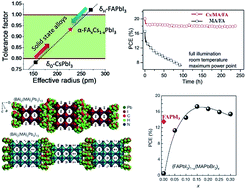
J. Mater. Chem. A, 2017,5, 11450-11461
https://doi.org/10.1039/C7TA00042A
Non-fullerene small molecule acceptors based on perylene diimides
This brief review summarizes non-fullerene acceptors based on perylene diimides used in bulk-heterojunction solar cells which were reported mainly during 2014–2016.
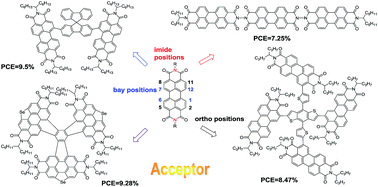
J. Mater. Chem. A, 2016,4, 17604-17622
https://doi.org/10.1039/C6TA06978A
Perylenediimides as non-fullerene acceptors in bulk-heterojunction solar cells (BHJSCs)
Perylenediimides are ideal candidates for the substitution of fullerene derivatives as electron acceptors in bulk heterojunction organic solar cells due to their extremely intense light absorbance, high electron mobility and excellent photochemical stability.
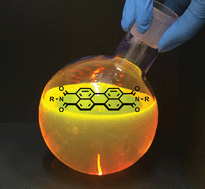
J. Mater. Chem. A, 2016,4, 9336-9346
https://doi.org/10.1039/C6TA02045C
Exploring the properties of lead-free hybrid double perovskites using a combined computational-experimental approach
Density functional theory screening of the hybrid double perovskites (MA)2BIBiX6 (BI = K, Cu, Ag, Tl; X = Cl, Br, I) was performed and (MA)2TlBiBr6, isoelectronic with MAPbBr3, was synthesised and found to have a band gap of ∼2.0 eV.
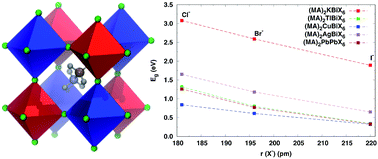
J. Mater. Chem. A, 2016,4, 12025-12029
https://doi.org/10.1039/C6TA05817E
A simple small molecule as an acceptor for fullerene-free organic solar cells with efficiency near 8%
A small molecule named DICTF was synthesized and an organic solar cell based on PTB7-Th:DICTF exhibited a high PCE of 7.93%.

J. Mater. Chem. A, 2016,4, 10409-10413
https://doi.org/10.1039/C6TA04358E
Indacenodithienothiophene–naphthalene diimide copolymer as an acceptor for all-polymer solar cells
With a low bandgap copolymer P(IDT-NDI) as an acceptor material and a medium bandgap polymer J51 as a donor material, efficient all-polymer solar cell are realized.

J. Mater. Chem. A, 2016,4, 5810-5816
https://doi.org/10.1039/C6TA01933A
Highly stable, phase pure Cs2AgBiBr6 double perovskite thin films for optoelectronic applications
Cs2AgBiBr6 double perovskite thin films were prepared and incorporated into photovoltaic devices featuring power conversion efficiencies close to 2.5%.
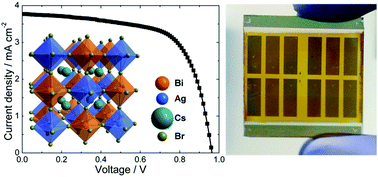
J. Mater. Chem. A, 2017,5, 19972-19981
https://doi.org/10.1039/C7TA06816F
Simple structured polyetheramines, Jeffamines, as efficient cathode interfacial layers for organic photovoltaics providing power conversion efficiencies up to 9.1%
The morphology and carrier transport of PTB7:PC71BM blend film were tailored through embedding the cathode modifying layer–Jeffamines. The Jeffamine D2000-derived inverted device displayed an enhanced PCE of 9.1% and a FF of 74.2%.
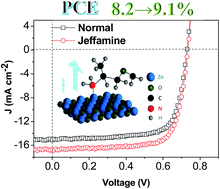
J. Mater. Chem. A, 2017,5, 10424-10429
https://doi.org/10.1039/C7TA02954C
Comparing non-fullerene acceptors with fullerene in polymer solar cells: a case study with FTAZ and PyCNTAZ
Non-fullerene acceptors (NFAs) are becoming a serious contender to fullerene-based electron acceptors in organic photovoltaics, due to their structural versatility and easily tunable optical and electronic properties.

J. Mater. Chem. A, 2017,5, 4886-4893
https://doi.org/10.1039/C6TA10450A
Template synthesis of CoSe2/Co3Se4 nanotubes: tuning of their crystal structures for photovoltaics and hydrogen evolution in alkaline medium
CoSe2 nanotubes have been used as highly efficient bifunctional electrocatalysts for both DSSCs and HER in alkaline medium.

J. Mater. Chem. A, 2017,5, 4513-4526
https://doi.org/10.1039/C6TA10718D
Mg-doped TiO2 boosts the efficiency of planar perovskite solar cells to exceed 19%
Higher charge transport, collection and final efficiency of planar perovskite solar cells are achieved with a Mg-doped TiO2 compact layer.

J. Mater. Chem. A, 2016,4, 15383-15389
https://doi.org/10.1039/C6TA06879K
Low-temperature plasma-enhanced atomic layer deposition of tin oxide electron selective layers for highly efficient planar perovskite solar cells
PEALD deposition was used to reduce the effective deposition temperature of SnO2 electron selective layers without compromising the performance of perovskite solar cells.
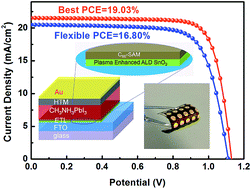
J. Mater. Chem. A, 2016,4, 12080-12087
https://doi.org/10.1039/C6TA04503K
A simple perylene diimide derivative with a highly twisted geometry as an electron acceptor for efficient organic solar cells
A perylene diimide based electron acceptor with a simple structure, low-cost and high efficiency of 5.65% is presented here.
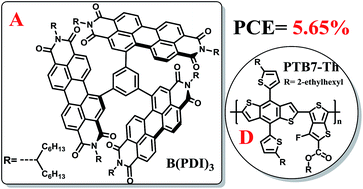
J. Mater. Chem. A, 2016,4, 10659-10665
https://doi.org/10.1039/C6TA04232E
Enhanced photovoltaic performance and stability of carbon counter electrode based perovskite solar cells encapsulated by PDMS
The encapsulation of carbon counter electrode based perovskite solar cells with PDMS is studied. The solar cells demonstrate a 54% enhancement over those without encapsulation and an impressive stability over 3000 h.
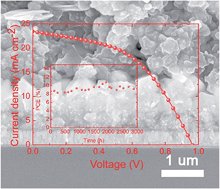
J. Mater. Chem. A, 2016,4, 10700-10709
https://doi.org/10.1039/C6TA02851A
A band-gap-graded CZTSSe solar cell with 12.3% efficiency
Using an appropriate SeS2/Se weight ratio, band gap grading was realized. By increasing the value of VOC through band gap grading in the depletion region, a record VOC deficit of 0.576 V and an efficiency of 12.3% were obtained.
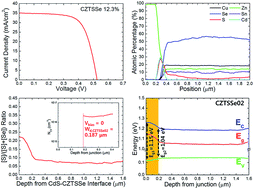
J. Mater. Chem. A, 2016,4, 10151-10158
https://doi.org/10.1039/C6TA01558A
Surface engineering of PbS quantum dot sensitized solar cells with a conversion efficiency exceeding 7%
A CdS passivation layer was introduced to a PbS QD surface to synthesize PbS/CdS core/shell QDs through an ion exchange procedure, achieving a record PCE of 7.19% for PbS-based liquid-junction quantum dot sensitized solar cells.

J. Mater. Chem. A, 2016,4, 7214-7221
https://doi.org/10.1039/C6TA02465C
Non-fullerene acceptor with low energy loss and high external quantum efficiency: towards high performance polymer solar cells
We present a non-fullerene electron acceptor bearing a fused 10-heterocyclic ring with a narrow band gap, which achieved a power conversion efficiency of 6.5% when paired with PTB7-Th.

J. Mater. Chem. A, 2016,4, 5890-5897
https://doi.org/10.1039/C6TA00612D
Achieving high-performance planar perovskite solar cell with Nb-doped TiO2 compact layer by enhanced electron injection and efficient charge extraction
A PSC based on 2% Nb-doped TiO2 achieved a PCE of up to 16.3%, which is consistent with a stabilized maximum power output of 15.8%.

J. Mater. Chem. A, 2016,4, 5647-5653
https://doi.org/10.1039/C6TA00989A
The mechanism of toluene-assisted crystallization of organic–inorganic perovskites for highly efficient solar cells
We investigate the influence of solvent drenching in hybrid organic–inorganic perovskite (CH3NH3PbX) crystallization process with a non-solvent, toluene, during film fabrication process.
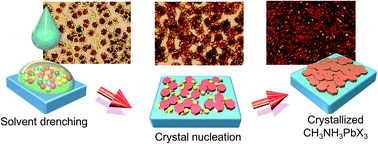
J. Mater. Chem. A, 2016,4, 4464-4471
https://doi.org/10.1039/C6TA01087C
A non-fullerene electron acceptor modified by thiophene-2-carbonitrile for solution-processed organic solar cells
An effective strategy to obtain a non-fullerene acceptor with good absorption and high electron mobility by introducing thiophene-2-carbonitrile groups.
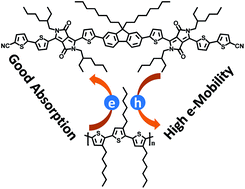
J. Mater. Chem. A, 2016,4, 3777-3783
https://doi.org/10.1039/C6TA00056H
About this collection
This third in a series of Journal of Materials Chemistry A Editor’s Choice collections focusses on photovoltaics.
The journal’s Associate Editor Christine Luscombe (University of Washington, Seattle, USA) has gathered together the journal’s most outstanding recent papers in photovoltaics.
This Editor’s Choice collection highlights the latest advancements made in the area of photovoltaics in the last couple of years. Two trends can be seen: (i) Work on non-fullerene acceptors has attracted significant interest with the highest organic photovoltaic (OPV) efficiency now reaching >14% due to the use of a non-fullerene acceptor; (ii) Work in the area of perovskite devices continues to grow with focus on increasing the efficiency and stability of these devices. Great advances continue to be made in the exciting field of photovoltaics.
In order to highlight developments in photovoltaics, this online collection summarizes recent experimental papers and reviews published on the topic.